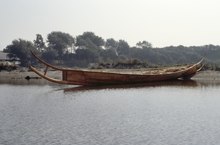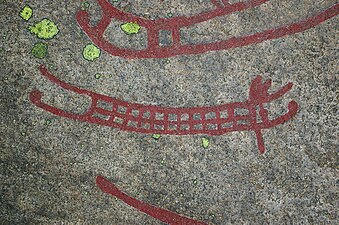Hjortspring boat

TheHjortspring boat(Danish:Hjortspringbåden) is a vessel designed as a largecanoe,from theScandinavianPre-Roman Iron Age.It was built circa 400–300 BC. The hull and remains were rediscovered and excavated in 1921–1922 from the bog ofHjortspring Moseon the island ofAlsinSønderjylland,southernDenmark.[1]The boat is the oldest find of a wooden plank ship inScandinaviaand it closely resembles the thousands ofpetroglyphimages ofNordic Bronze Ageships found throughout Scandinavia.[2]The vessel is aclinker-built wooden boat of more than 19 metres (62 feet)length overall,13.6 metres (45 feet) long inside, and 2 metres (6.6 feet) wide. Tenthwartsthat could have served as seats, span the boat with room for two persons each; this suggests space for a crew of at least 20 who propelled the boat withpaddles.[2]The boat would have weighed an estimated 530 kilograms (1,170 pounds), making it easily portable by its crew.
Associated finds[edit]

When found, the boat contained a great quantity of weapons and armour, including 131 shields of theCeltictype, 33 well-craftedShield Boss es,138 iron spearheads, 31 bone or antler spearheads, 11 single-edged iron swords, and the remains of severalmailcoats.Two of the swords weredeliberately bent,a practice associated with Iron Age rituals. The largest of the spearheads is a massive 43.5 centimetres (17.1 inches) long. The find also contained bowls, boxes,blacksmith's tools, and other everyday goods. The sinking of the vessel in the bog has been interpreted as a deliberatevotive offering.[3]This is reinforced by the presence of a dismembered horse placed beneath the boat at the time of burial along with a lamb, a calf, and two dogs.Numerous graveshave been discovered in Denmark from this time period containing similargrave goodsandsacrificedhorses, dogs, lambs, cows, other animals, andhuman beings.[4][5][6][7]
Construction[edit]

The Hjortspring boat was constructed oflime(linden) wood plankssewntogether with cord oflime bark,spruce root, orrawhide.Pitchwas used to caulk and coat the seams to make the boat watertight. A longdugout logforms the bottom plank, which also acts as thekeel,with two additional planks, orstrakes,attached on both sides to fashion the hull. This allows the large vessel to sit high in the water and to traverse shallow waters, even with a full crew and heavy load. Hollowed timbers were used to create the distinct stem and stern-posts. These stem pieces, along with the bottom plank, extend forward and backward from the hull to form the iconic "beaks" of this type of boat construction. Vertical oak struts, secured by woodenpegsand pitch, fasten the upper and lower "beaks" and brace both ends of the watercraft. Thin limbs of hazel form theribswhich were lashed to cleats in the planks. These cleats were made by carving down the rest of the plank boards; this created a strong attachment point without a need for fastening each cleat separately by lashing or pegs to the long planks of the hull. The hull planks and hazel ribs are supported by thwarts and thicker supporting ribs ofash.
The high level of craftsmanship present in the archaeological find indicates that the boatbuilding methods used to construct the Hjortpsring boat are significantly older than the boat itself.[8]
Later history of this type[edit]
Watercraft of this style and construction were built and used at least until the 3rd century AD. Metalrivetsbecome increasingly present in later finds and the stem construction was simplified to a single curved shape which extended and tapered outward from the hull. These later stems, orprows,were made of single pieces of wood or multiple pieces joined. Much of the essential boatbuilding methods found in the Hjortspring boat persisted into theViking Age.This continuation can be seen in the boat finds from Halsnøy (200 AD),Nydam(300-400 AD),Sutton Hoo(600-700 AD), andKvalsund(690 AD).[9]
Modern Reconstruction- The Tilia Alsie[edit]
A full reconstruction of the Hjortsprung Boat was launched in 1999.[10]
See also[edit]
- Iron Age Scandinavia
- Dugout canoe
- Sewn boat
- Lashed-lug boat
- Clinker (boat building)
- Nydam Mose
- Ship burial
- Bog body
- Death in Norse paganism
- National Museum of Denmark
References[edit]
- ^Thorkild Ramskou (1965).Danmarks oldtid.Guides to the National Museum (Nationalmuseet (Denmark)) (in Danish). Copenhagen. p. 43.ISBN9788748068513.OCLC43695721.
{{cite book}}:CS1 maint: location missing publisher (link) - ^abPauline Asingh (2009).Grauballemanden: portræt af et moselig(in Danish). Copenhagen: Gyldendal A/S. p. 195.ISBN978-87-02-05688-4.
- ^Thomas Dickson (2009).Dansk design.Gyldendal A/S. pp. 31–2.ISBN978-87-02-07768-1.
- ^P. V. Glob;Rupert Bruce-Mitford(trans.) (1969).The Bog People: Iron-Age Man Preserved.London: Faber and Faber Ltd. pp. 185–86.OCLC1014843010.
- ^Flemming Kaul (1988).Da våbnene tav: Hjortspringfundet og dets baggrund(in Danish). Copenhagen: Danish National Museum.ISBN9788717060234.
- ^Klavs Randsborg(1999). "Into the Iron Age: A Discourse on War and Society". In John Carman; Anthony Harding (eds.).Ancient Warfare: Archaeological Perspectives.Stroud: Sutton. pp. 191–202.ISBN9780750917957.
- ^Klavs Randsborg (1996).Hjortspring: Warfare and Sacrifice in Early Europe.Århus: Århus University Press.ISBN9788772885452.
- ^Arne Emil Christensen (1968).Boats of the North: A History of Boatbuilding in Norway.Norsk kulturarv. Vol. 2. Oslo: Det Norske Samlaget. pp. 18–20.OCLC964234377.
- ^A. W. Brøgger;Haakon Shetelig;Katherine John (trans.) (1951).The Viking Ships: Their Ancestry and Evolution.Oslo: Dreyers Forlag. pp. 48–60.OCLC464543657.
- ^"The Hjortspring Boat's sister Tilia Alsie".
Further reading[edit]
- Ole Crumlin-Pedersen and Athena Trakadas (eds.),Hjortspring: A Pre-Roman Iron-Age Warship in Context,[Ships and Boats of the North Volume 5], Roskilde: Viking Ship Museum 2003;ISBN8785180521
External links[edit]
- "The Guild of the Hjortspring Boat".
- Foteviken Museum."The Hjortspring boat".Archived fromthe originalon 2006-02-10.Retrieved2005-08-28.
- "Bibliography on the boat".Southampton University. Archived fromthe originalon 2005-01-01.
- "Review of Crumlin-Pedersen's book".University College London.
- "The conservation of the boat".Danish National Museum. Archived fromthe originalon 2005-08-28.
- Axel Nelson."Fartyg Före Vikingatiden"[Pre-Viking Age Scandinavian Ships] (in Swedish).




